GlyCORE News & Announcements
November 2022
Meet GlyCORE’s Analytical and Biophysical Chemistry Research Core
By Ellie Price
OXFORD, Miss. - The Analytical and Biophysical Chemistry Research Core exists to assist researchers in answering questions about their research in analytical chemistry as it relates to glycoscience, either through running samples, or consulting and offering advice.
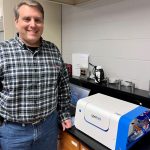 “We help researchers develop methods for making careful measurements of their systems, for understanding how those methods work at a fundamental level, and we help interpret those results,” the Core’s director, Dr. Joshua Sharp, said. “People can submit samples to the Research Core, and we will consult with them and run the experiments for them. That includes everything from simple things like measuring the mass of molecules to complex things like three-dimensional structure studies and binding kinetics.”
“We help researchers develop methods for making careful measurements of their systems, for understanding how those methods work at a fundamental level, and we help interpret those results,” the Core’s director, Dr. Joshua Sharp, said. “People can submit samples to the Research Core, and we will consult with them and run the experiments for them. That includes everything from simple things like measuring the mass of molecules to complex things like three-dimensional structure studies and binding kinetics.”
The Core has recently brought in new equipment to help achieve its goals in assisting researchers.
“The National Institutes of Health gave us a supplemental award to bring in a Luminex FLEXMAP 3D system,” Sharp said, “This is a multiplex analyzer that basically allows researchers to quantify many different molecules in their solution at once using some relatively simple kits. We recently also purchased what is known as a surface plasmon resonance instrument. This is a tool that is really good for understanding how molecules bind to each other.”
While the Core prioritizes aiding research based at the University of Mississippi, it also expands its tools throughout the region and the world.
“We will take on selected clients if they have problems that fall within our area of interest,” Sharp said. “For example, we are currently working with a European researcher helping them understand how a particular protein they have binds to a particular glycoside they are interested in. This would help them understand how this particular organism interacts with microbes, and that is something we are very good at.”
Interested in receiving assistance from the Core? Visit the Analytical and Biophysical Chemistry Research Core page on this website, and fill out the sample submission form.
“The main thing to know about the Core is the earlier you get in touch with us the more we can help. We want to help people better understand the systems they are working with. So anytime people feel like they are getting stuck, they should feel free to reach out.”
Dr. Sharp serves as the Core’s director, Dr. Sandeep Misra is the Core manager, and Dr. Anter Shami is a senior chemist.
October 2022
Dr. Ross Receives International Award
By Ellie Price
OXFORD, Miss. - Dr. Samir Ross, a principal investigator in the Glycoscience Center of Research Excellence, was recently honored as The Best Foreign Scientific Supervisor of the Kazakhstan National Medical University (KazNMU).
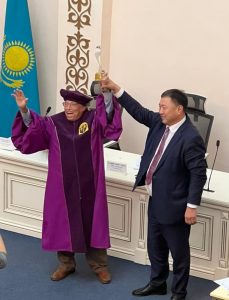 “It is a great honor and joy to me, and it is an excellent advertisement to the School of Pharmacy at the University of Mississippi,” Ross said. “I am the first professor to receive this award from KazNMU.”
“It is a great honor and joy to me, and it is an excellent advertisement to the School of Pharmacy at the University of Mississippi,” Ross said. “I am the first professor to receive this award from KazNMU.”
Ross accepted his award on a 10-day trip to Kazakhstan.
“My trip involved giving a lecture about the collaboration between the University of Mississippi and KazNMU on our scientific work,” Ross said. ”I also gave scientific lectures to the faculty and PhD students.”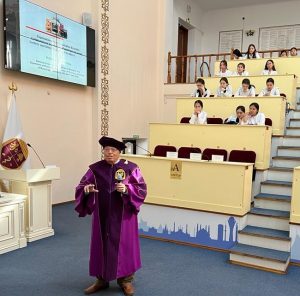
Ross began his partnership with KazNMU in 2011 as a PhD supervisor. Since then, he has supervised 14 PhD students. During his trip, he was able to check on his KazNMU students of the past and present.
“Ten of my students have graduated, and now have very attractive jobs,” Ross said. “One of my students from 2011 invited me over for dinner. She now has several medical companies and is very successful. Four of my students will complete their defense and graduate in April. My collaboration with KazNMU is continuing and prosperous”
May 2022
GlyCORE Computational Chemistry and Bioinformatics Research Core's Priyanka Samanta Receives Fellowship
By: Erin Bradley
OXFORD, Miss. - Priyanka Samanta was awarded the D.E. Shaw Research (DESRES) Graduate and Postdoc Women's Fellowship where she and other fellowship attendees took part in a two-day event in New York City.
The fellowship is targeted toward graduate students and postdocs who apply computation, machine learning, or theoretical approaches to address important scientific problems in chemistry, biophysics, or drug discovery. Each year they select a total of 20 candidates.
The fellowship provided an opportunity to make a technical presentation at an event organized by D.E. Shaw Research, attend a career development panel, and take a tour of the supercomputer Anton.
Samanta is a research assistant for GlyCORE's computational Chemistry and Bioinformatics Research Core. The fellowship required a write-up and presentation of the student's research, so Samanta's work conducted as part of GlyCORE was an important addition to her application.
"Our collaborative work with members of GlyCORE was an integral part of the fellowship application and was presented as a "Flash Talk" in the event that the fellowship supports," Samanta said.
Samanta encourages all women graduate students and postdocs in the computational field to apply for the DESRES Fellowship. "It might just answer your question in mind, "academia or industry after graduation?" Samanta said.
For more information on the DESRES Fellowship, visit https://www.deshawresearch.com/womensfellowship/.
Meet GlyCORE’s Imaging Research Core
By Erin Bradley
OXFORD, Miss. – The GlyCORE Imaging Research Core, located in 114 Shoemaker Hall, provides access to advanced imaging techniques for GlyCORE investigators.
The primary goal of the Imaging Research Core is to help individuals collect data using imaging instrumentation.
 “If they come to us with samples they would like to image, we can help them collect that data,” says Core Director, Dr. Gregg Roman. “More recently we’ve been helping people prepare their samples for imaging because there are many people here who do not have the ability or experience in sample preparation.”
“If they come to us with samples they would like to image, we can help them collect that data,” says Core Director, Dr. Gregg Roman. “More recently we’ve been helping people prepare their samples for imaging because there are many people here who do not have the ability or experience in sample preparation.”
The Imaging Research Core consults with people to let them know what type of data they can collect. The Core collects data in x, y, z and t. x, y and z being the three spatial dimensions and t being over time.
The Core provides services such as Stereomicroscopy, Epifluorescent and Bright Field Microscopy, Laser Scanning Confocal Microscopy, imaging flow cytometry and fluorescence-based quantitative PCR to University of Mississippi investigators.
“We further help investigators collect data using the Field-Emission Scanning Electron Microscope,” says Dr. Roman. “Overall, if an investigator wishes to look inside tissues or cells to see changes in glycans or what glycans are doing, we can help with that.”
The Imaging Research Core has several ongoing projects, working with different investigators, developing new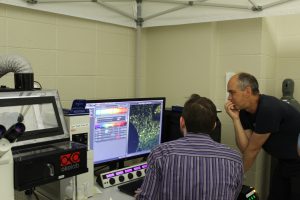 techniques helping them collect more and better data.
techniques helping them collect more and better data.
“We probably have 5 or 6 projects that we are currently working on,” says Dr. Roman. “ We are actively collaborating with a number of folks.”
The Imaging Research Core functions day to day with the guidance of Core Director, Dr. Gregg Roman, and Core Manager, Dr. Ruofan Cao.
As Core Director, Dr. Roman is responsible for making sure that Dr. Cao has everything he needs. He assists Dr. Cao with the consultations and reaches out and helps other investigators.
As Core Manager, Dr. Cao attends to the instruments to make sure they function correctly, help people prepare the sample for the image and train them to make sure they are familiar with the instrument so they can do their own imaging process.
“Dr. Roman and I work together to expand the function of the Core and to collaborate on our strategic visions for the Core,” says Dr. Cao.
The Imaging Research Core has a very important role in expanding the understanding of what glycans are doing in the various systems that GlyCORE’s investigators are working with. GlyCORE is based around these relatively understudied molecules that have very important biological functions. Without the imaging core, investigators would have no way to see what's happening where those molecules are doing their work. The Core provides those investigators with an avenue to answer those questions and have views that they otherwise would never have.
“We love collaborating with people and if anyone is even just curious on how imaging can impact their work, we are here,” says Dr. Roman. “We love to talk to people and really want to help people.”
To request access to the Imaging Research Core’s instrumentation, submit a service request form.
For more information, contact Dr. Gregg Roman at groman@olemiss.edu or Dr. Ruofan Cao at rcao1@olemiss.edu.
April 2022
GlyCORE’s Computational Chemistry and Bioinformatics Research Core receives new technology
By Erin Bradley
OXFORD, Miss.-- The Computational Chemistry and Bioinformatics Research Core (CCBRC) at the University of Mississippi (UM) added Gag, a new graphical-processing unit (GPU) server for scientific computing, to their lab this past March.
The CCBRC secured the GPU Server through their funding from the US National Institute of General Medical Sciences of the National Institutes of Health (NIH) as part of a major glycoscience initiative at UM called GlyCORE..
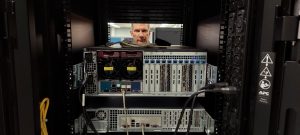 “CCBRC has already been very successful at the utilization of the NIH funding for advances in applications of computational glycoscience and we look forward to using this resource to accomplish even more exciting science in support of new and experienced glycoscientists at UM, in the region, and around the world,” said CCBRC director, Prof. Robert Doerksen.
“CCBRC has already been very successful at the utilization of the NIH funding for advances in applications of computational glycoscience and we look forward to using this resource to accomplish even more exciting science in support of new and experienced glycoscientists at UM, in the region, and around the world,” said CCBRC director, Prof. Robert Doerksen.
This server is equipped with dual 8x NVIDIA RTX A5000 GPUs. It will be used for running molecular dynamics simulations of large biomolecular systems and machine learning calculations. All GlyCORE users will be able to use the server for different kinds of GPU computations for glycoscience.
“I am excited to have these new GPUs added to CCBRC computing resources. This machine will help me manage CCBRC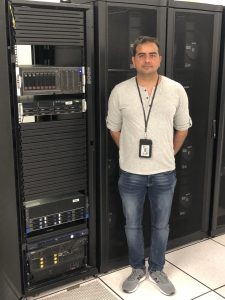 computational resources more effectively, and now CCBRC users can perform MD simulations of very large systems having up to about 10 million atoms,” said CCBRC manager, Dr. Sushil Mishra.
computational resources more effectively, and now CCBRC users can perform MD simulations of very large systems having up to about 10 million atoms,” said CCBRC manager, Dr. Sushil Mishra.
This new machine is now in the UM Data Center and is accessible through secure internet. It will be available for all the CCBRC users starting in May 2022. Right now, it is in a testing mode in which software is being installed and testing is underway for the hardware and software.
This machine will be primarily dedicated to glycoscience research by GlyCORE members, but all UM researchers are welcome to inquire and/or apply for use of GlyCORE resources such as the Gag.
To request access to Gag or other resources, fill out the CCBRC Service Request Form for computer access:
https://pharmacy.olemiss.edu/glycore/computationalchemistrybioinformaticscore
For more information contact Prof. Robert Doerksen at rjd@olemiss.edu and Dr. Sushil Mishra at sushil@olemiss.edu.
Werfel receives NSF CAREER award
By Erin Bradley
OXFORD, Miss.-- Thomas Werfel, assistant professor at the University of Mississippi’s Department of Biomedical Engineering and a GlyCORE Junior Investigator Project Leader, received the National Science Foundation (NSF) Faculty Early Career Development (CAREER) award.
The NSF CAREER awards are early-career grants given to professors with the potential to make an impact on STEM in the United States through both research and educational outreach. Werfel received a five-year grant for $597,638 to fund his project titled “Multimodal Biomaterials for Sequential Delivery of Diverse Immunotherapeutic Cargos.”
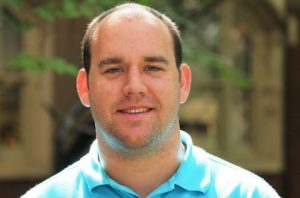 “I plan to build materials that can better train and sustain immune responses both for the purpose of better vaccine development and to improve cancer immunotherapies,” Werfel said. “I also plan to do educational outreach by contributing to a summer Research Experience for Undergraduates (REU) and by hosting a Nanobiotechnology “Excursion” for North MS high school students.”
“I plan to build materials that can better train and sustain immune responses both for the purpose of better vaccine development and to improve cancer immunotherapies,” Werfel said. “I also plan to do educational outreach by contributing to a summer Research Experience for Undergraduates (REU) and by hosting a Nanobiotechnology “Excursion” for North MS high school students.”
Werfel’s current project seeks to overcome the shortcomings of immunotherapies and radically improve the ability to program immune responses. The human immune system is diverse and capable of responding to all types of challenges with precise control over the timing and area of the response, but immunotherapies are typically delivered all at once as single therapies, without regard to the spatial and dynamic considerations of delivery. If successful, the project will produce innovative new polymeric technologies with applications ranging from vaccine development to immuno-oncology, having the potential to significantly improve healthcare in the United States.
“These awards are critical for research because they support the hiring of personnel, purchasing of materials and supplies, and contribute to career/professional development,” said Werfel.
March 2022
GlyCORE to host second annual Mid-South Glycoscience Meeting
By Erin Bradley
OXFORD, MISS. -- The Glycoscience Center of Research Excellence (GlyCORE) at the University of Mississippi will host its second annual Mid-South Glycoscience Meeting.
The meeting will take place at the Thad Cochran Research Center on June 16, 2022, and will be a stage for Mid-South glycoscience researchers and trainees to present their work and have a chance to network.
Prof. Samir Ross, one of two directors of GlyCORE and professor of pharmacognosy, is excited to continue the success of last year’s meeting.
“Last year we had a very successful meeting and this year we are looking for a more expanded meeting, more attendants and more collaborations,” said Ross. “ The purpose of GlyCORE is to develop an interdisciplinary center to support glycoscience research throughout the Mid-South region.”
Prof. Joshua Sharp, director of GlyCORE and associate professor of pharmacology, chemistry and biochemistry, shares the same aspirations of continued success.
“As we grow, this meeting gives our Research Cores a chance to showcase how we can help support glycoscience researchers in the Mid-South region,” said Sharp.
Attendees of the meeting will hear from an impressive group of keynote speakers. Those speakers include Dr. Richard Cummings of Beth Israel Deaconess Medical Center and Harvard Medical School, Dr. Kelley Moremen of the University of Georgia and Dr. Susan Bellis of the Heersink School of Medicine, the University of Alabama at Birmingham.
“The Mid-South Glycoscience Meeting is a great chance for the University of Mississippi to host top glycoscientists from the region and around the world to share the exciting new advances in carbohydrate chemistry, glycobiology and related topics,” said Sharp.
A virtual option will be available for attendees who are unable to attend the meeting in person, but all are encouraged to attend in person.
Visit the GlyCORE meeting webpage for more information and to register for the meeting.
February 2022
GlyCORE’s Analytical and Biophysical Chemistry Research Core receives new technology
By Erin Bradley
OXFORD, Miss. — The Analytical and Biophysical Chemistry Research Core received two new tools to add to the research lab this past January: the Luminex FlexMap 3D and the Nicoya OpenSPR.
The Core received the Luminex FlexMap 3D through a grant from the National Institute of General Medical Sciences and secured the Nicoya OpenSPR through existing funds in the Glycoscience Center of Research Excellence (GlyCORE).
The Luminex FlexMap 3D is most commonly used to measure the concentration of many different molecules in a sample at the same time, while the Nicoya OpenSPR will allow the Core to measure how two molecules interact and how tightly two molecules bind together.
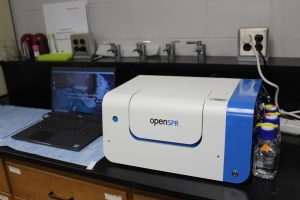
Nicoya OpenSPR
According to Prof. Joshua Sharp, Core Director of the Analytical and Biophysical Chemistry Core, the Core has exciting plans for the use of their new technology.
“Our initial plan with the Nicoya OpenSPR is to work with Dr. Vitor Pomin’s group to study the binding properties of some of his marine polysaccharides. This will help us link the physical properties of the polysaccharides with their biological activities,” said Sharp.
The Core also has exciting plans for the FlexMap 3D.
“We are eager to use the FlexMap 3D to analyze changes in gene and protein expression in our transgenic mice deficient in advanced glycation end product
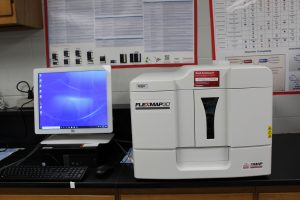
Luminex FlexMap 3D
signaling,” said Dr. Nicole Ashpole, one of GlyCORE’s Pilot Project Program Investigators. “This FlexMap 3D allows us to design customized arrays capable of measuring dozens of inflammatory cytokines, glycans and genes in a single tissue sample. These studies will help us understand the relationship between biological aging and our signaling pathway.”
Training on the new technology took place on Feb. 14 and 17 for the Nicoya OpenSPR and the Luminex FlexMap 3D respectively through remote training and walk-through experiments.
This technology is open to any University of Mississippi investigators.
For further information or access, contact Prof. Sharp at jsharp@olemiss.edu.
GlyCORE announces new student organization
By Erin Bradley
OXFORD, Miss. — The Glycoscience Center of Research Excellence (GlyCORE) at the University of Mississippi is excited to announce the establishment of a new student organization, the Glycoscience Student Advocates (GSA), at the beginning of the 2022 spring semester.
GSA is designed to promote glycoscience knowledge by encouraging interdisciplinary glycoscience trainees in their research, education, and training.
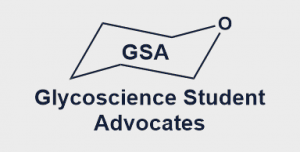 GSA is founded on creating a voice for graduate and undergraduate students at the university who are interested in the different fields of glycoscience.
GSA is founded on creating a voice for graduate and undergraduate students at the university who are interested in the different fields of glycoscience.
“GSA aims to provide a platform for its members by giving them the opportunity to
nominate external speakers to monthly GSA meetings, the GlyCORE monthly seminar series, and the annual Mid-South Glycoscience Meeting,” says Maali Alshammari, president of GSA and fourth year graduate student in the Department of BioMolecular Sciences .
In addition, GlyCORE will fund three travel awards annually to GSA members to attend national glycoscience-related conferences and meetings. This provides its members networking and collaboration opportunities that will further their career in glycoscience.
GSA will not only support students on their path to success in the glycoscience field but also as professionals.
“GSA will help students develop leadership skills such as planning and organizing by getting them involved in hosting events such as the annual Mid-South Glycoscience Meeting,” says Alshammari.
GSA is open to all graduate and undergraduate students at the University of Mississippi and is currently recruiting students to serve as officers or members.
For more information about GSA contact President Maali Alshammari at malshamm@go.olemiss.edu or Student Organization Advisor Karin Ballering at kkballer@olemiss.edu.
GlyCORE welcomes external speaker for February Seminar Series!
By Erin Bradley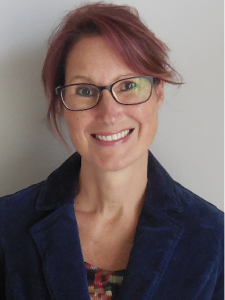
OXFORD, Miss. — Prof. Christine Szymanski will join the Glycoscience Center of Research Excellence’s (GlyCORE) Seminar Series as an external speaker on Wednesday, February 23, 2022, at 1 p.m. CST.
Prof. Szymanski first began working with Campylobacter jejuni during her Ph. D. studies in the Department of Medical Microbiology and Immunology at the University of Alberta in Edmonton, Canada. She is currently a Professor in the Department of Microbiology at the University of Georgia, where she continues to study C. jejuni and the link between microbial glycans and glycosides and human immunity.
Szymanski will present her research seminar titled “Ganglioside antibodies, mother’s milk and glycoconjugate vaccines are compounds in our arsenal to avert Campylobacter-induced disease” at this month’s Seminar Series that will take place virtually over Zoom.
For further information, to request the Zoom link or if you require special assistance relating to a disability, please contact Karin King Ballering, 915-5153, kkballer@olemiss.edu, at least four days before the event.
January 2022
Ross Earns Highest Honor from Asfendiyarov National Kazakh Medical University
 January 5, 2022
January 5, 2022
OXFORD, Miss. – Samir Ross, professor of pharmacognosy and research professor, was recognized as Honorable Professor and awarded a Gold Medal from Asfendiyarov National Kazakh Medical University in Almaty, Kazakhstan.
The honor was presented to Ross for scientific collaboration with the Kazakh pharmacy school for almost a decade, which includes giving seminars, workshops and supervising 10 Ph.D. graduate students both abroad and in Mississippi. The Gold Medal is the institution’s highest honor.
Read More: "Ross Earns Highest Honor from Asfendiyarov National Kazakh Medical University"
December 2021
American Cancer Society funds UM professor's breast cancer research

December 15, 2021
OXFORD, Miss. – A University of Mississippi biomedical engineer is searching for new treatments for metastatic breast cancer using a nearly $800,000 grant from the American Cancer Society.
Read More: Study of How Cancers Spread Promises Treatment Options
October 2021
GlyCORE hosts the third seminar of the Seminar Series and introduces its first presentation from a Research Core!
By Lauren Kate Drewry
The Glycoscience Center of Research Excellence (GlyCORE) held its third seminar of the new Seminar Series on Oct. 19 in the Thad Cochran Research Center.
This seminar highlighted a profound research presentation by Ashpole Lab graduate research assistant, Cellas Hayes, and a literature presentation by Imaging Core Manager, Ruofan Cao.
Cellas Hayes started the seminar with his research presentation, “AGE/RAGE Signaling Impacts on Healthspan: Early-life Cognitive Assessments.”
 “Our GlyCORE pilot project focuses on understanding how the systemic knockout of AGE receptors (RAGE) will delay the onset of cognitive and physical impairments and reduce neurodegeneration drivers,” Hayes said. “In our body, we naturally produce advanced glycation end products (AGEs) which have been implicated in several aging pathologies. Although studies have shown that targeting upstream pathways of AGEs can extend lifespan, there is still multiple unknowns. ”
“Our GlyCORE pilot project focuses on understanding how the systemic knockout of AGE receptors (RAGE) will delay the onset of cognitive and physical impairments and reduce neurodegeneration drivers,” Hayes said. “In our body, we naturally produce advanced glycation end products (AGEs) which have been implicated in several aging pathologies. Although studies have shown that targeting upstream pathways of AGEs can extend lifespan, there is still multiple unknowns. ”
Hayes finds this research exciting due to the long-term studies their lab is able to do.
“This study allows us to understand how the natural production of AGEs and their ability to accumulate inside the cells through RAGE influences health span including muscle coordination, cognitive, and sleep/wake cycles,” said Hayes. “Rarely, in our research do we get to follow our studies for an extended period of time to truly see and interpret how something like AGE/RAGE signaling contributes to the onset of aging pathologies and diseases.”
Hayes finds that this research could lead to future pharmacological breakthroughs that would increase lifespan and more importantly the quality of life or healthspan.
“Upon completion, these results will indicate if AGE/RAGE signaling is a side effect of aging or if it directly promotes aging,” said Hayes. “And if it directly accelerates aging, we could further develop pharmacological interventions to target the downstream pathways to slow this accelerated aging improving health whether that be motor coordination, circadian rhythms, weight loss/frailty, and cognition.”
Imaging Core Manager, Ruofan Cao, presented on the literature article, “Protein-retention expansion microscopy of cells and tissues labeled using standard fluorescent proteins and antibodies.”
“This is a technology to increase the imaging resolution. Our current confocal have the resolution about 300 nm,”
 said Cao. “With the Expansion Microscopy (ExM), the resolution could be increased to 70 nm. Basically, instead of adding a super-resolution module to the microscopes itself (Which could cost more than 500K), this ExM would physically expands the samples equally in all directions, so we could get the similar results as super-resolution module with the current confocal system.”
said Cao. “With the Expansion Microscopy (ExM), the resolution could be increased to 70 nm. Basically, instead of adding a super-resolution module to the microscopes itself (Which could cost more than 500K), this ExM would physically expands the samples equally in all directions, so we could get the similar results as super-resolution module with the current confocal system.”
Cao feels that this technique will push the boundaries of the imaging capabilities in GlyCORE’s Imaging Core.
“It helps to resolves more detailed structures of biological samples,” Cao said. “ExM will also make the sample more transparent and increase the depth of imaging. ExM could also be used on glycans imaging with Click-Chemistry.”
According to Cao, it will become a tool in GlyCORE for getting super-resolution images.
GlyCORE’s mission is to advance the capabilities of their investigators and provide them with the tools they need to do groundbreaking research.
“The GlyCORE provides the Ashpole lab the opportunity to complete a pilot project without reduces funds and having to choose between other projects,” said Hayes. “As a graduate trainee, it allows me the opportunity to conduct research outside of my dissertation while presenting my findings to both researchers here at the UM and other glycobiology researchers. Ultimately, it provides a unique opportunity and space for both junior investigators and their trainees to start or complete a project that would otherwise have to be postponed and not largely invested in until federal funding was provided which could be years from now.”
The next series will be held on Nov. 16 in the Thad Cochran Research Center or via Zoom at 2 p.m. The next presentations are by Alex Vinson from the Colby Lab, and Arif Mohammad from the Werfel Lab.
September 2021
GlyCORE hosts second seminar of the new Seminar Series with two profound presentations
By Lauren Kate Drewry
The Glycoscience Center of Research Excellence (GlyCORE) held its second seminar of the new Seminar Series on Sep. 21 in the Thad Cochran Research Center.
Each month GlyCORE hosts a seminar with two presentations. One is a research presentation highlighting current research within GlyCORE, and the other is a literature presentation on a current article published by outside authors in the field.
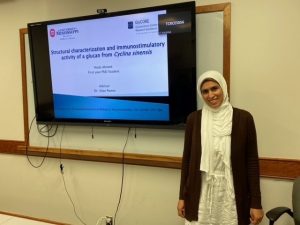 GlyCORE research assistant Hoda Ahmed from Dr. Vitor Pomin’s lab kicked off the seminar with her literature presentation on the article, “Structural characterization and immunostimulatory activity of a glucan from Cyclina sinensis.”
GlyCORE research assistant Hoda Ahmed from Dr. Vitor Pomin’s lab kicked off the seminar with her literature presentation on the article, “Structural characterization and immunostimulatory activity of a glucan from Cyclina sinensis.”
“The literature article I presented included an intensive work to determine the structural information of a polysaccharide isolated from the marine clam Cyclina sinensis,” Ahmed said. “It was also included the immunostimulatory activity of the isolated polysaccharide considering the structure activity relationship.”
Ahmed took an interest in this research while working at her Core Facility.
“Since I graduated from pharmacy school, I chose to study natural products chemistry and my goal is to discover new drugs of higher potency and minimal or no side effects,” said Ahmed.
Ahmed finds that similar research conducted at GlyCORE will shed light on future drug discovery.
Research assistant Kayleigh Phillips from Dr. Cole Stevens’s lab presented the research presentation, “Myxobacterial response to biofilms and secreted virulence factors from pseudomonads.”
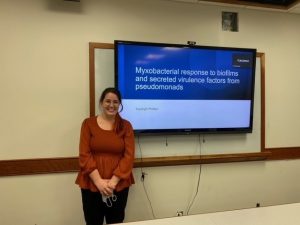 “My research is about myxobacteria and their transcriptional and metabolic response to quorum sensing molecules such as 4-hydroxy-2-heptylquinoline (HHQ) and acyl-homoserine lactone (AHL) exhibited from prey bacteria,” Phillips said. “Also, it’s how novel myxobacteria respond to membrane features, alginate, exhibited by common clinically relevant bacteria shown through predation assays.”
“My research is about myxobacteria and their transcriptional and metabolic response to quorum sensing molecules such as 4-hydroxy-2-heptylquinoline (HHQ) and acyl-homoserine lactone (AHL) exhibited from prey bacteria,” Phillips said. “Also, it’s how novel myxobacteria respond to membrane features, alginate, exhibited by common clinically relevant bacteria shown through predation assays.”
Phillips foresees this research to have a significant impact on future myxobacteria research.
“This research aims to discover new specialized metabolites and further understand how other prey bacteria respond to myxobacteria metabolism and how myxobacteria respond to their prey’s quorum-sensing molecules,” said Phillips.
According to Phillips, she first became interested in this research through working with the pharmaceutical industry and handling microorganisms.
According to the Glycoscience Center of Research Excellence, the Seminar Series will allow GlyCORE the opportunity to highlight local glycoscience research and display the capabilities of the Research Cores.
GlyCORE’s mission is to help advance the work of their investigators by equipping them with the materials needed to conduct research as well as expanding their access to the glycoscience community throughout the Mid-South.
“GlyCORE has been an excellent avenue for learning more about the glycoscience field from other scientists through the annual meetings and having access to different research cores that provide various equipment, such as mass spectrometry, to improve our research capabilities,” said Phillips. “These opportunities have allowed for honing valuable skills needed to be a better scientist.”
The next series will be held on Oct. 19 in the Thad Cochran Research Center or via Zoom at 2 p.m. The next presentations will come from Dr. Nicole Ashpole’s lab and GlyCORE’s Imaging Core.
August 2021
GlyCORE kicks off its first Seminar Series with groundbreaking student research presentations
By Lauren Kate Drewry
The Glycoscience Center of Research Excellence (GlyCORE) held its first seminar of the new Seminar Series on Aug. 24 in the Thad Cochran Research Center. GlyCORE will host a seminar with presentations from two GlyCORE researchers once every fourth week.
Each seminar will include a research presentation about current research from within GlyCORE and a literature presentation on an impactful article from an author outside of GlyCORE followed by a period of discussion.
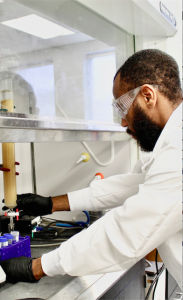 2nd-year chemical engineering Ph.D. student Oluwaseyi Shofolawe-Bakare, from Dr. Thomas Werfel’s lab, kicked off the seminar with his research presentation, “ABC Triblock Glycopolymers for macrophage-targeting and ROS-responsive drug delivery.”
2nd-year chemical engineering Ph.D. student Oluwaseyi Shofolawe-Bakare, from Dr. Thomas Werfel’s lab, kicked off the seminar with his research presentation, “ABC Triblock Glycopolymers for macrophage-targeting and ROS-responsive drug delivery.”
“These novel nanoparticles take advantage of the carbohydrate-related mechanisms in the immune system to selectively inhibit immunosuppressive processes that drive the progression of cancer,” Shofolawe-Bakare said. “It can also be used to specifically deliver drugs to treat other inflammation-related diseases.”
Shofolawe-Bakare finds that this research is very significant in advancing treatments for cancer and other diseases in the future.
“The nanoparticles engineered in this work will be used for the selective drug delivery of hydrophobic drugs,” said Shofolawe-Bakare. “In addition, the knowledge gained from this work provides valuable insight into how glycoscience can be wielded as a powerful tool to improve therapeutic outcomes in a variety of diseases."
According to Shofolawe-Bakare, the most exciting part of this research is the process of engineering these sophisticated nanoparticles and their potential to .
 GlyCORE graduate student Amena Begum from Dr. David Colby’s lab presented a literature presentation on the article, “Stereochemistry of Transition Metal Complexes Controlled by the Metallo-Anomeric Effect” by Feng Zhu and Maciej A. Walczak.
GlyCORE graduate student Amena Begum from Dr. David Colby’s lab presented a literature presentation on the article, “Stereochemistry of Transition Metal Complexes Controlled by the Metallo-Anomeric Effect” by Feng Zhu and Maciej A. Walczak.
Begum took an interest in this research after seeing it originally presented at the Mid-South Glycoscience Meeting.
“This was presented by a professor in the glycoscience seminar this summer, so when I saw the professor’s presentation, I was very interested to learn and chose this topic,” said Begum.
Begum foresees this literature article to have a significant impact on future glycoscience research.
“In the future, I think [this research] is very important for the drug design,” said Begum. “The flexibility of this transition metal catalyst in an anomeric position means this research is very significant.”
According to the Glycoscience Center of Research Excellence, the goal of the Seminar Series is to “aid in the establishment and development of a community of GlyCORE-affiliated researchers as well as researchers with potential future interests or intersections with glycoscience.”
GlyCORE has helped foster and support these investigators’ works and has provided them with the tools they need to advance their research and knowledge of glycoscience.
“The GlyCORE Computational Core has done an incredible job simulating how our nanoparticles would bind to our target cells,” said Shofolawe-Bakare. “More so, the wealth of knowledge about glycoscience displayed at the monthly GlyCORE meetings and the questions asked have shaped the way I think about my research and glycoscience in general."
The next series will be held on Sep. 21 in the Thad Cochran Research Center or via zoom at 2 p.m. The next presentations will come from Kayleigh Phillips from Dr. Cole Stevens’s lab and Hoda Ahmed from Dr. Vitor Pomin’s lab.
June 2021
Faculty, Researchers Honored by School of Pharmacy
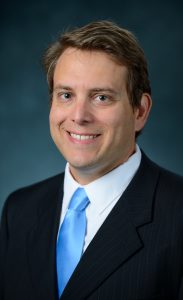
Joshua Sharp
Joshua Sharp, associate professor of pharmacology, was recognized for his research with the Cumberland Pharmaceuticals Inc. Faculty Research Award.
Sharp has secured funding for numerous projects during his time with the school. Among those was a $7.5 million grant to establish the Glycoscience Center of Research Excellence, which he serves as director. GlyCORE supports glycoscience investigators through direct funding of research projects, while providing new researchers with opportunities for mentorship and networking.
Sharp’s writing has also been widely noticed by his peers. Cited more than 1,400 times, Sharp has published more than 60 papers, with 15 appearing in the past three years.
May 2021
GlyCORE to Host Inaugural Mid-South Glycoscience Meeting

Joshua Sharp
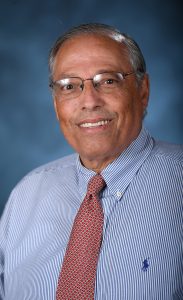
Samir A. Ross
OXFORD, Miss. – The Glycoscience Center of Research Excellence at the University of Mississippi School of Pharmacy is set to host the inaugural Mid-South Glycoscience Meeting.
The meeting is slated for July 19 at the Thad Cochran Research Center. The one-day event will be a venue for Mid-South glycoscience researchers and their trainees to feature their work, network and establish new opportunities for collaboration.
Read more: GlyCORE to Host Inaugural Mid-South Glycoscience Meeting
February 2021
Up Front: The Science Behind the COVID-19 Vaccines with Dr. Sharp
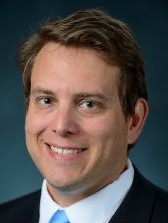
Joshua Sharp
Joshua Sharp, faculty member with the School of Pharmacy, will be sharing the science behind the COVID-19 vaccines and answering general questions on the development of vaccines on Tuesday, Feb. 9 at 1 p.m. CT through the Ole Miss Alumni Association's Up Front Speaker Series.
Attendees will better understand what a vaccine is, how it works and why it is effective. Learn from an expert about what you need to know about the COVID-19 vaccines.
The Zoom Webinar is free and open to the public. Registration required at olemissalumni.com/events. Submit your vaccine questions at the Google Form.
November 2020
Understanding COVID-19 Topic for Virtual Oxford Science Cafe

Joshua Sharp
November 11, 2020
OXFORD, Miss. – The infection processes of the COVID-19 virus are the topic for a virtual Oxford Science Cafe scheduled for Nov. 17 by University of Mississippi faculty researchers.
The program will be hosted on Zoom beginning at 6 p.m. Joshua Sharp, associate professor of pharmacology and director of the UM Glycoscience Center of Research Excellence, will discuss “COVID-19 and Heparan Sulfate: The Carbohydrate Handle that SARS-CoV-2 Uses to Grab Your Cells.”
You may view the recorded discussion at the following link: “COVID-19 and Heparan Sulfate: The Carbohydrate Handle that SARS-CoV-2 Uses to Grab Your Cells.”
September 2020
UM Researchers Working on Nasal Spray COVID-19 Treatment

Joshua Sharp
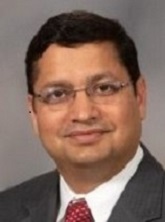
Ritesh Tandon
September 16, 2020
OXFORD, Miss. - A team of researchers, including faculty from the University of Mississippi schools of Pharmacy and Medicine, are developing a treatment that could be effective at preventing COVID-19. The good news is that it's something that you can easily carry in your bag.
Read More:
"UM Researchers Working on Nasal Spray COVID-19 Treatment"
July 2020
Glycoscience Research Center Established at School of Pharmacy

Joshua Sharp
July 20, 2020
OXFORD, Miss. – The University of Mississippi has received a $10.5 million Centers of Biomedical Research Excellence Phase I grant from the National Institutes of Health to establish a new center dedicated to glycoscience, funded for the first year at $2,107,042.
The Glycoscience Center of Research Excellence, known as GlyCORE, will study how carbohydrates and carbohydrate-containing molecules affect human health.
Read More: "Glycoscience Research Center Established at School of Pharmacy"
